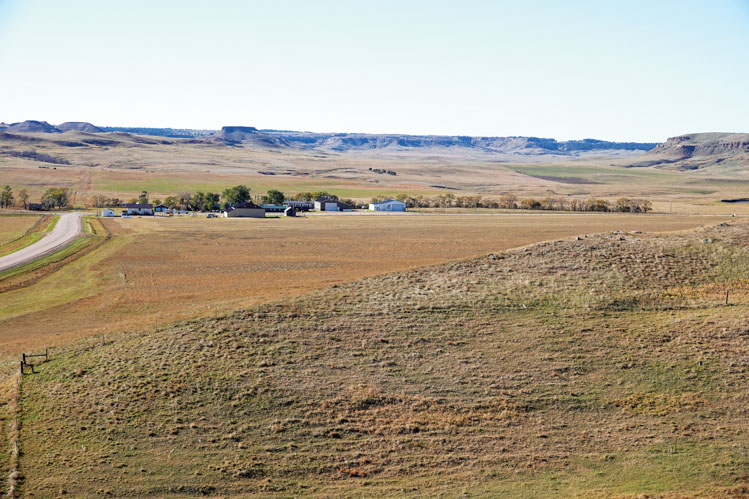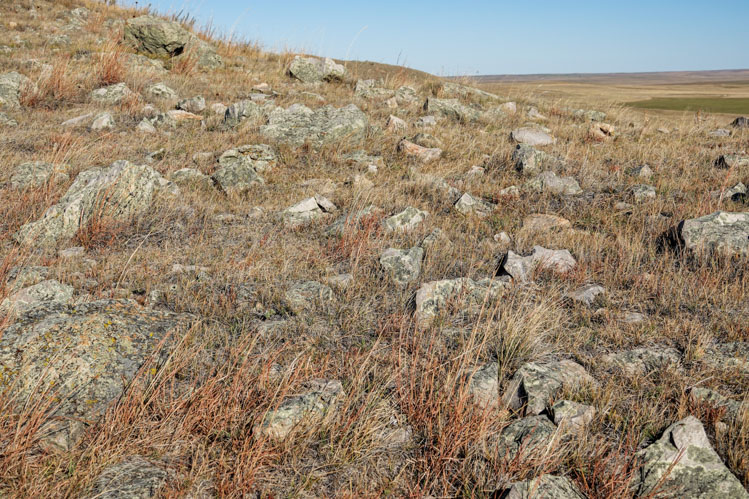The Gift of South Dakota
Subscriptions to South Dakota Magazine make great gifts!
Subscribe today — 1 year (6 issues) is just $29!
Winter Potatoes
 |
| Silcrete rocks, unique in North America, dot the pastures around Ludlow in Harding County. |
When we were growing up on our ranch near Ludlow, we called them flint rocks, though an old timer wittily referred to them as winter potatoes. They are actually siliceous rocks, formed during the Paleocene Epoch (56 to 66 million years ago), numerous on hills and ridges around Ludlow and quite rare on the continent.
Geologists believe that silcrete formed from siliceous waters (rich in silica, a common mineral) in a swampy environment when the region was warm, humid and covered with vegetation. Rocks are made up of minerals and this silcrete is composed of silt sized grains of quartz in a matrix of microcrystalline quartz. Evidence of ancient stems and roots of plants can be found in the rocks; holes and impressions left by that ancient plant material remain.
The very top layer of Flint Butte (a butte northeast of Ludlow known by locals as Flat Top) is an intact solid layer of silcrete and measures 2 to 3 feet thick. It is hard and resistant to erosion. Over the years, softer underlying rock and deposits eroded away, leaving silcrete material and rocks on the surface hills and ridges. The Ludlow area silcrete deposit has been mapped for 30 miles, from the North Cave Hills to Lodgepole. Similar silcrete beds are found in South Africa and Australia.
 |
| The Harding County rocks are between 56 million and 66 million years old. |
Native Americans used these rocks to make tools and weapons and to anchor tipis. Large rocks can still be seen hanging on fence posts where opportunistic ranchers used barbed wire to attach them to keep posts from pulling out of the ground. We remember building and fixing fences, and like our neighbors, looked for silcrete rocks with natural holes made by ancient roots. The holes are very useful; barbed wire can be run through, which allows for easy attachment. In fact, evidence of old abandoned fence lines in Harding County can be traced to a trail of rocks. Local landmarks such as Tepee Buttes and Flint Butte are covered with silcrete rocks, and they are very numerous among pastures along Highway 85 about a mile north of Ludlow.
Generations of farmers and ranchers have piled the rocks on the edges of fields and cursed them as they took a toll on their farm equipment. We remember the horrific screeching of a disc blade grating against a silcrete rock and watching towed implements jump into the air when striking one. Many oil pans, differentials and steering components have been scarred and punctured by ranchers and hunters driving across pastures where these jagged rocks were hidden in tall grass. It is a sickening sound when a low-slung vehicle encounters one of these sharp-edged rocks. Many a prairie fire has started when mowers and swathers hit silcrete rocks during dry conditions.
Ludlow’s silcrete rocks are unique in North America with an interesting history and use. They are rugged, windswept, and hardened, like generations of inhabitants who walked these lands.
Thomas M. Welch is a retired agricultural educator and Wayne G. Welch is a retired petroleum engineer. Both remain involved with the family ranch near Ludlow.
Editor’s Note: This story is revised from the July/August 2022 issue of South Dakota Magazine. To order a copy or to subscribe, call (800) 456-5117.










Comments